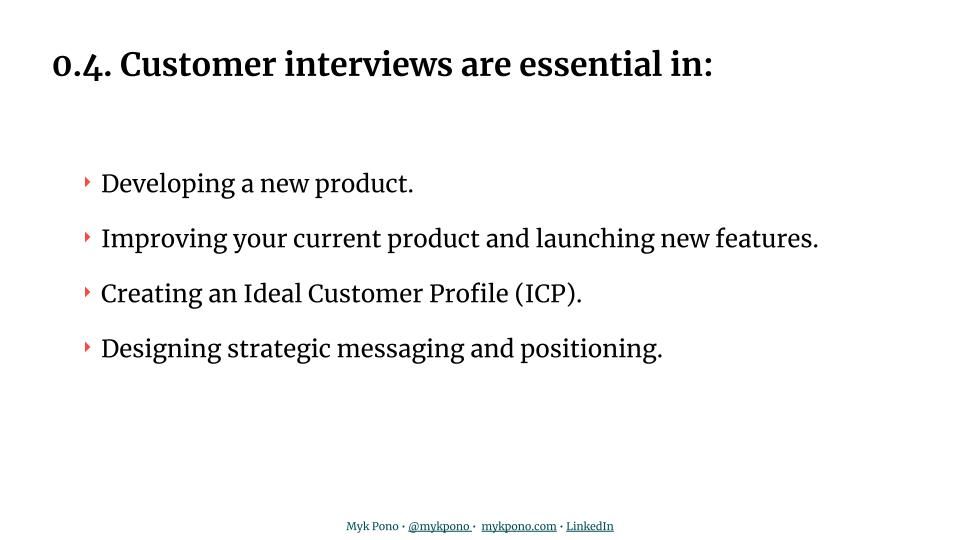Course 0.4: Customer Interviews | How Customer Interviews Fit Into Your Marketing Process

Updated: https://lab.mykpono.com/free-course-Customer-User-Interviews-13cbee28614780feb9b9fbe594eb145c
0.4. How Customer Interviews Fit Into Your Marketing Process
By now you understand the immense value of customer interviews. Now come the next questions:
When should I do them?
How do they fit into my overall process? Ideally, you should be speaking with your customers regularly.
But there are 3 major instances when you MUST talk to your customers. Let's discuss each.
First is when you’re developing a new product. A couple of years ago I was working on a product called Publishnow. It was a content publishing platform that made it easy for anyone to start a blog, grow its audience, and generate subscription revenue.
When we were first developing it, I conducted over 200 customer interviews!
It seems like a lot, but it was invaluable in testing assumptions about my understanding of my customers and their problems. It also helped me prioritize the features to focus on first. Now I’m not saying that you need to talk to 200 people every time you create something new.
To start, I recommend aiming for at least 20 interviews.
This is doable for any sized team and you’ll still walk away with powerful insights.
For example, one of the most interesting things that we have learned talking to the customer is that we believed that the problem of publishing was obvious.
So I'd kick off the interview by asking questions like, “how difficult is your content publishing process right now?”
But often people we interviewed were NOT AWARE of how difficult it is. So instead, I started asking broader questions like “walk me through your process of publishing.”
And as they describe this process they can see HOW complicated it is.
Then I would follow up with questions like “If we eliminate steps 2 -4 in this process, how valuable that would be?”
The second time to talk to your customers is when improving your product or launching a new feature of your existing product.
Customer interviews can help you get started by understanding how your customers use your product now.
WHEN do they use it?
What do they want to achieve with it?
You don't want to create a complicated user flow or a feature that no one will use.
That's why, early in the development process, the BEST companies run their ideas, prototypes, and sometimes even their mockups by their customers.
Remember the quote by Steve Blank - “Get out of the building and get in front of your customers.”
The third time when it’s important to conduct customer interviews is when you are developing your Ideal Customer Profile and customer messaging.
By the way, I have an in-depth article on creating an Ideal Customer Profile on my website at mykpono.com.
As you’ll see, I highlighted in the article that the first step in creating a strong ICP is to conduct interviews with customers and prospects.
There’s simply no other way to get this done.
To recap, it’s important to talk to customers regularly but, at a minimum, use customer interviews in these 3 instances: creating a new product, improving or adding a new feature to an existing product, and developing your Ideal Customer Profile and brand messaging.
Before we dive into designing our customer interviews, I want to leave you with two quick caveats:
First, not all customer interviews are created equal. You need to achieve two things to call your interviews a success.
First, there are surprising insights. Have you ever talked to someone and they say something and your eyebrows go up? And you say, hmm, interesting. THAT’S a surprising insight.
Don't brush over these moments in your interviews, stay on the topic, ask follow-up questions, and go deeper.
For example, as a Lead Product Manager for Email Threat Scanner at Barracuda, I conducted multiple customer interviews to understand how we can showcase our product value better.
Part of our Email Threat Scanner was a domain analysis using something called DMARC.
As we interviewed customers, we were surprised to learn that IT managers in mid-size and smaller organizations don't know much about DMARC.
Our first inclination was to remove DMARC analysis from our dashboard.
However, after shadowing a few demos on which sales reps went through scan results, we realized that DMARC is an important part of the company's security.
It was just our job to explain the value of it to IT managers and why they should care about it.
If your customer interviews didn’t provide you with any surprising insights like this, you aren’t learning anything.
Your customer interviews also need to provide you with actionable insights. In other words, insights you can DO something with.
For example, let’s say the goal of your customer research is to help you understand how to improve a product.
When interviewing the customers, you learn that their process takes them 3 times longer than it should -- and it’s costly for the team.
Well, perhaps you can improve the product to make this process more streamlined. THAT’s your actionable insight.
It’s an insight that you can take and DO something with.
If all you managed to generate are high-level takeaways or ambiguous feedback, you haven’t learned anything to help you improve your product.
That doesn’t mean that every customer interview you conduct needs to provide both surprising and actionable insights.
No matter how well you prep, you’ll get into some conversations that don’t give you anything useful. That’s ok and expected.
Instead, challenge yourself to capture surprising and actionable insights from within EVERY batch of interviews you complete.
If you aren’t walking away with something useful, you either need to change your approach or the people you’re interviewing to get better information.
Finally, keep in mind that while they are incredibly powerful, customer interviews are not the be-all, and end-all in product development.
Remember, your customers don’t know what they don’t know.
They can tell you what they want, but not necessarily what they need.
The desires your customers reveal should only be one factor that influences your decision-making.
As an example, if you’re developing a new product, you can’t only go off of what customers tell you they want.
You have to consider their needs relative to variables such as cost, time to deliver, your product’s competitive advantage, and your company’s Unique Selling Proposition.
Learn everything you can from your customers and prospects, but be mindful of the other factors at play when it comes to decision-making.
Resources / Exercises:
- When should you conduct customer interviews?
- Understand the limitations of customer interviews - what kind of insights can and can’t you generate?
- You don’t know what you don’t know
- Customers can tell you what they want; not necessarily what they need
- Why people think they do something, vs why they do it: https://www.producttalk.org/2016/03/customer-interview-questions/
- Customer interview data sets are generally small - their findings aren’t guaranteed to be relevant across your entire user base
- Customer desires should only be one factor that influences your decision-making
EX: When seeking insight when developing a new product, customer feature requests need to be considered relative to cost/time to deliver, your intended competitive advantage/USP, etc
Exercise:
- Write down a list of initiatives you have planned for your team in the next months or quarters. Which of them could benefit from customer/prospect interviews?
- Write down the goal for each of the initiatives and what you need to learn from your customers in order to make this initiative a success.
